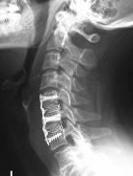
|
ALVIN HONG NEUROSURGERY |
|
Surgery for Brain, Spine & Nerves |

|
To Contact Dr Hong
Phone : +65 6733 8803 Fax : +65 6836 0949 Emergencies : +65 6535 8833 E-mail : dralvinhong@gmail.com |
|
Neck arthritis is very common as one gets older. There are many names for this “wear and tear” condition including cervical spondylosis, cervical degenerative disease, and osteoarthritis.
Other neck problems include disc prolapse (herniated disc), tumours and accidents.
Neck problems typically present in 3 ways :
1. Neck pain only. 2. Neck pain with numbness or pain or weakness in the arms (called a radiculopathy). 3. Neck pain with weakness, numbness or stiffness in the legs (called a myelopathy).
Pure neck pain can result from poor posture (especially when using the computer), being overweight or with excessive physical activity. The pain comes from disc degeneration, irritating the facet joints in the back of the neck and the resulting muscle spasm in the paraspinal muscles that run along the back of the spine. It is not due to nerve compression, and surgery will not help. Treatment involves correcting one’s posture and doing exercises to condition the neck.
If the nerve is compressed as it leaves the spine, there may be pain down the arm to where the nerve supplies. If it is badly affected, there may be numbness or weakness of the muscles that the nerve supplies. This is called a radiculopathy.
In some people, the spinal cord (that runs through the neck on its way to the lower part of the body) may be compressed. Typically, there is stiffness, cramps, weakness and numbness in the legs. Occasionally, there may even be problems controlling the bowels and bladder. This is called a myelopathy.
Although the most useful investigation to look at the neck is an MRI scan, abnormalities are found in almost everyone. It is crucial the patient is seen first, for a detailed account of the symptoms followed by a careful examination. This is to determine if the nerves or spinal cord are affected, and if so, at which part of the neck.
An operation to free the nerves or spinal cord may help some people. The aim is to prevent further worsening and give the best chance of some improvement.
The surgical approach and type of surgery will have to be tailored for each patient :
· Anterior discectomy and fusion, using a bone graft from above the hip or a titanium plate & cage. · Anterior discectomy and disc replacement. · Posterior decompression via a laminoplasty or laminectomy.
Many patients only spend 2 to 3 nights in hospital. |
Neck Problems |



|
Before operation (showing midline disc pressing on the spinal cord) |

|
After operation (showing plenty of space around the spinal cord) |

|
Post-operative X-ray showing plates & cages in place |